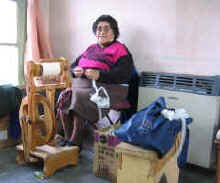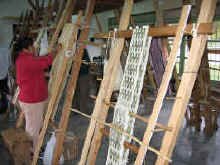This morning we visited the town of El Bolson which was the first town in Argentina to declare itself a "non-nuclear zone" and an "ecological municipality". The town was populated back in the 1970's by "hippies" and is full of natural food and craft stores. The area also produces 3/4 of the country's hops (used in beer production). The town is nestled in a valley surrounded by snow-covered peaks and is an absolutely gorgeous area. We visited a Mapuche (the local indigenous group who survived the Spanish colonial period) cooperative before leaving town and were fascinated by the women spinning yarn on foot-powered spinning wheels. The co-op produced all kinds of crafts including woven textiles and carved wood items.
|
|
|
After leaving El Bolson we continued north passing lake after lake with their colorful surroundings of color-changing trees. We eventually arrived in the city of Bariloche, which among other things is known for its alpine architecture with a Patagonian style, utilizing local hardwoods and stone construction. Driving toward the city, we once again had that "twilight zone" experience - as we drove closer to town the distance signs show greater distances to go!
After driving through the heart of town (which we usually try to avoid, but we got lost), we found the road that would take us on the Circuito Chico northwest of the city. This road wound around the Lago Nahuel Huapi and visited the town of Colonia Suiza, a town settled by Swiss pioneers in the 1930's. We spent the night on the edge of town alongside a small river.
We woke up this morning to our first truly clear sky. This called for a celebration, so we took a ride on the "Aerosilla", a chair-lift but literally the "air seat", up to the top of a 1,000 meter high mountain that promised spectacular views across the Lago Nahuel Huapi and the snow capped mountains that stretch from Bariloche to the Chilean border. Lago Nahuel Huapi is over 100 km (62 miles) long and covers an area of over 500 square km (300 sq. miles) - it is huge. Yes, we can report that the promise was true, we had an excellent view all around. We took our time enjoying the view and drank a couple of cups of tea at the lookout. This was fortunate as we found that the electrical power was intermittent and we might have gotten stuck on the lift when the power went off for 30 minutes!

Afterwards, we stopped off to take a walking tour through Bariloche. The town center is regarded as the main showplace, it was designed to take advantage of the fantastic views of the lake and the buildings were built using locally available materials - especially the wood. The buildings look like the large log buildings that can be found in western Canada and Alaska. We toured the local museum to view the Mapuche displays and artifacts. It is amazing how similar indigenous peoples of the Americas look, some of the photographs could have easily been confused with photos taken of North American Indians in the late 19th Century.
Continuing our drive around the lake, we found a National Park campground on the lake at the mouth of a rushing river. It was just perfect, and on top of that we found that the parks do not charge admission fees during their winter season.
Today was a border crossing day, first, exiting Argentina and then entering Chile. Again the formalities went quickly and smoothly, even though the Chilean guards did a quick inspection of our Fuso looking for contraband meat and vegetables! They even checked our storage compartments, but we satisfied them with our responses that they contained only truck parts and camping equipment (the truth, of course).
The border is at the top of the Paso Cardenal Samore at the height of about 3,000 meters - just a short little mountain top. The drive was beautiful, going up, up and up through the mountains until we nearly reached the snow line. Then after crossing into Chile it was down, down, down but at a much quicker pace. We had a great view of the Volcano Puyehue which erupted in 1960 the day after Chile suffered a major 8.6 (Richter Scale) earthquake. Read more on our Chile page.
We thought it would be fun to sit in a hot springs in the Volcano park and went to a couple of different "Termas" or hot springs. But after checking them out we realized that all they were, were big hot swimming pools, so we decided to pass. At night we made camp along the shore of Lago Llanquihue in the old German settlement of Puerto Octay.
April 24th and Don's birthday found us rushing down to Puerto Varas where we expected to find our new refrigerator, generously replaced by our sponsor Dometic/Tundra and shipped down to Chile for us. Arriving at the Compass del Sur hostel where the refrigerator was supposed to be shipped, the owner - Mauricio - telephoned around and found that it was being held in a warehouse in Puerto Montt, about 30 minutes away. We headed down to the warehouse only to find that they wanted us to pay for shipping to our original destination of Coyhaique. So we headed off to the main office for LAN Courier to discuss this with them. They agreed to reduce the price to the actual shipping costs - how nice - and we were able to go back and get our fridge. The warehouse guys were really nice and let us drive the Fuso into the warehouse (it was raining outside) and work on replacing the fridge for the next couple of hours. One of their truck drivers even got into the act and became a helpful assistant, helping Don remove the old fridge and lift the new beast into the living quarters. All things went well and we now have a new, updated, WORKING refrig.
After we finished hooking everything up, even though it was getting dark, we drove another 50 km (30 miles) further south, then traveled by ferry across to Island Grande Chiloe where we made camp for the night parked on the main square of the port, Chacao.

